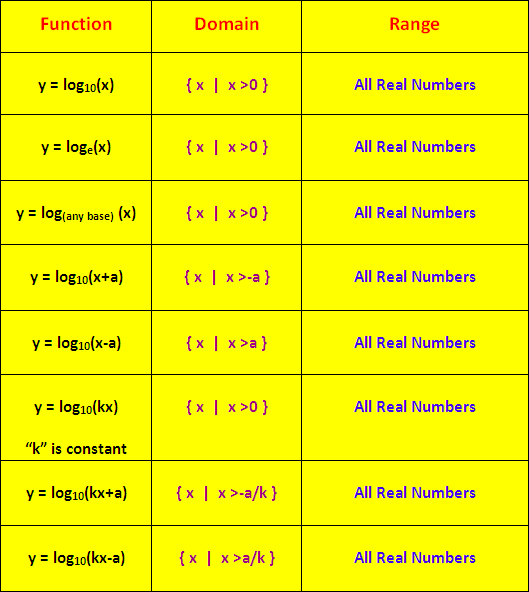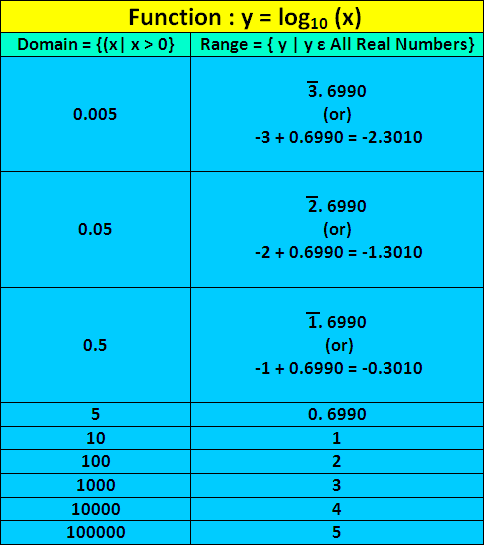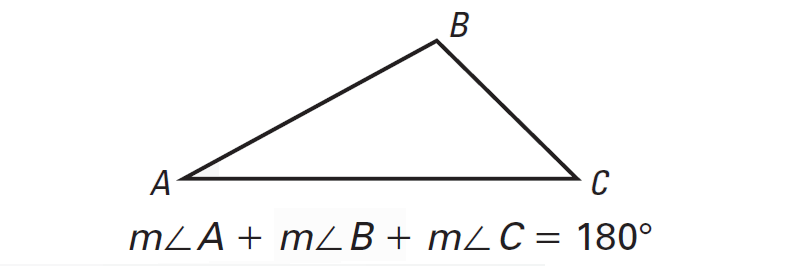DOMAIN AND RANGE OF LOGARITHMIC FUNCTIONS
In this section, you will learn how to find domain and range of logarithmic functions.
The table shown below gives the domain and range of different logarithmic functions.

Name of the Parts of a Logarithm
Usually a logarithm consists of three parts.
Let us come to the names of those three parts with an example.
log10A = B
In the above logarithmic function,
10 is called as Base
A is called as Argument
B is called as Answer
Fact to be known about domain of logarithm functions
A very important fact that we have to know about the domain of a logarithm to any base is,
"A logarithmic function is defined only for positive values of argument"
For example, if the logarithmic function is
y = log10x,
then the domain is
x > 0 or (0, +∞)
Domain of y = log₁₀ (x)
In the logarithmic function
y = log10(x),
the argument is 'x'.
From the fact explained above, argument must always be a positive value.
So, the values of x must be greater than zero.
Therefore, the domain of the above logarithmic function is
x > 0 or (0, +∞)
Domain of y = log₁₀ (x+a)
In the logarithmic function
y = log10(x+a),
the argument is 'x+a'.
From the fact explained above, argument must always be a positive value.
So, the values of 'x+a' must be greater than zero.
Then,
x + a > 0
Subtract 'a' from each side.
x > -a
Therefore, the domain of the above logarithmic function is
x > -a or (-a, +∞)
Domain of y = log₁₀ (x-a)
In the logarithmic function
y = log10(x-a),
the argument is 'x-a'.
From the fact explained above, argument must always be a positive value.
So, the values of 'x-a' must be greater than zero.
Then,
x - a > 0
Add 'a' to each side.
x > a
Therefore, the the domain of the above logarithmic function is
x > a or (a, +∞)
Domain of y = log₁₀ (kx)
In the logarithmic function
y = log10(kx),
the argument is 'kx'.
From the fact explained above, argument must always be a positive value.
So, the values of 'kx' must be greater than zero.
Then,
kx > 0
Divide each side by 'k'.
x > 0
Therefore, the the domain of the above logarithmic function is
x > 0 or (0, +∞)
Domain of y = log₁₀ (kx+a)
In the logarithmic function
y = log10(kx+a),
the argument is 'kx+a'.
From the fact explained above, argument must always be a positive value.
So, the values of 'kx+a' must be greater than zero.
Then,
kx + a > 0
Subtract 'a' from each side.
kx > -a
Divide each side by k.
x > -a/k
Therefore, the the domain of the above logarithmic function is
x > -a/k or (-a/k, +∞)
Domain of y = log₁₀ (kx-a)
In the logarithmic function
y = log10(kx-a),
the argument is 'kx-a'.
From the fact explained above, argument must always be a positive value.
So, the values of 'kx-a' must be greater than zero.
Then,
kx - a > 0
Add 'a' to each side.
kx > a
Divide each side by k.
x > a/k
Therefore, the the domain of the above logarithmic function is
x > a/k or (a/k, +∞)
Some more stuff on domain of logarithmic functions
Let us consider the logarithmic functions which are explained above.
y = log10(x)
y = log10(x+a)
y = log10(x-a)
y = log10(kx)
y = log10(kx+a)
y = log10(kx-a)
Domain is already explained for all the above logarithmic functions with the base '10'.
In case, the base is not '10' for the above logarithmic functions, domain will remain unchanged.
For example, in the logarithmic function
y = log10(x),
instead of base '10', if there is some other base, the domain will remain same. That is
x > 0 or (0, +∞)
Range of Logarithmic Functions
The table shown below explains the range of y = log10(x).
That is,
"All Real Numbers"

Here, we may think that if the base is not 10, what could be the range of the logarithmic functions?
Whatever base we have for the logarithmic function, the range is always
"All Real Numbers"
For the base other than '10', we can define the range of a logarithmic function in the same way as explained above for base '10'.
Kindly mail your feedback to v4formath@gmail.com
We always appreciate your feedback.
©All rights reserved. onlinemath4all.com
Recent Articles
-
Writing Quadratic Functions in Standard Form
Apr 27, 24 12:13 AM
Writing Quadratic Functions in Standard Form or Vertex Form -
How to Find the Vertex of a Quadratic Function in General Form
Apr 27, 24 12:06 AM
How to Find the Vertex of a Quadratic Function in General Form -
Sum of the Three Angles of a Triangle
Apr 26, 24 09:20 PM
Sum of the Three Angles of a Triangle - Concept - Solved Examples
